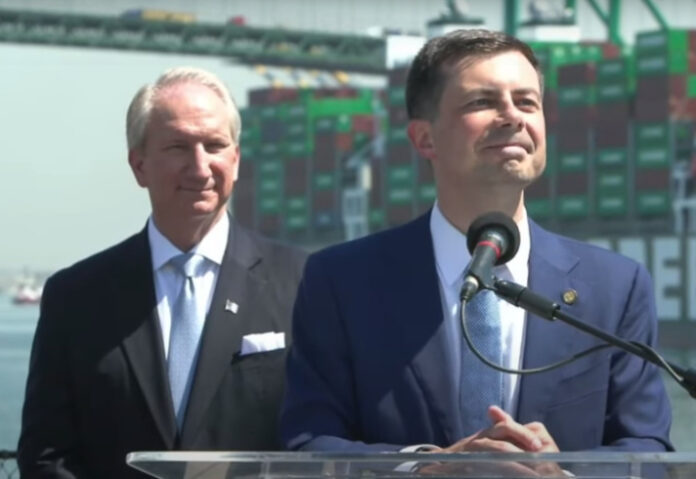
-
US$20 million federal infrastructure grant will finance a critical road-railway grade separation project that will improve truck access and speed up cargo flow the port
-
US Transportation Secretary Pete Buttigieg said he recognized there’s so much to do to fix the supply chains torn up by the pandemic and make them more resilient for long
-
The award comes from the Department of Transportation’s Rebuilding American Infrastructure with Sustainability and Equity (RAISE) discretionary grant program
Los Angeles Port got a US$20 million federal grant on September 8 for a critical road-railway grade separation project that would help resolve congestion at the Western Hemisphere’s busiest gateway.
US Transportation Secretary Pete Buttigieg, who brought the grant, praised the progress being made at the port to improve cargo flow, saying he recognized “there is so much more to do to fix the supply chains that were torn up by the pandemic and to make them more resilient for years to come”.
The $20 million award comes from the Department of Transportation’s Rebuilding American Infrastructure with Sustainability and Equity discretionary grant program, which received more funding under the Infrastructure Investment and Jobs Act passed by Congress in 2021.
RAISE grants focus projects backing roads, bridges, transit, rail, ports and intermodal transport.
“We are delighted to formally celebrate the award of $20 million to the Port of Los Angeles to reduce trucking delays and allow freight trains to move goods more rapidly, reducing shipping costs as part of the fight against inflation,” Buttigieg said.
Facilitating faster cargo movement, the new roadway configuration will streamline truck access to an important container and chassis-access facility on the port’s Terminal Island, reducing traffic delays, truck dwell times and greenhouse gas emissions from idling vehicles.
“L.A.’s port isn’t just the backbone of our region’s prosperity – it’s one of America’s most powerful economic drivers, and a crossroads that helps connect our country to the rest of the world,” said Los Angeles Mayor Eric Garcetti. He said the roadway will help the port move cargo more efficiently and meet critical sustainability goals.
Port of Los Angeles executive director Gene Seroka hailed the “milestone moment” in US ports investment as he applauded Buttigieg “for bringing…critical funding to where it’s needed most.”
Seroka had his hands full for the past two years seeking ways to resolve port congestion that left cargo vessels mostly from Asia waiting several days to unload, driving up freight rates to historic levels and causing supply chain chaos that raised the costs of goods for consumers.
The project will entail construction of a four-lane, rail-roadway grade separation, which will allow unimpeded truck access to an 80-acre marine support facility (MSF) on Terminal Island, a central location serving all terminals in the San Pedro Bay port complex.
Access to this facility for chassis and empty shipping container storage is impeded by several heavily used rail tracks and a tunnel with low vertical clearance, which the project will address.
The new rail-roadway will connect trucks directly to the highway system in two directions, reducing 2,500 truck-hour delays daily; cutting emissions by more than 3,000 metric tons a year; and saving 1,200 truck miles traveled per day, thus reducing potential road accidents in the area, the port said in a press release. The project will generate 300 new jobs.
The Port of Los Angeles has ranked as the No.1 container port in the US for 22 consecutive years. In 2021, the port facilitated $294 billion in trade and handled 10.7 million twenty-foot equivalent units (TEUs) of containers, the busiest calendar year in its 115-year history.




